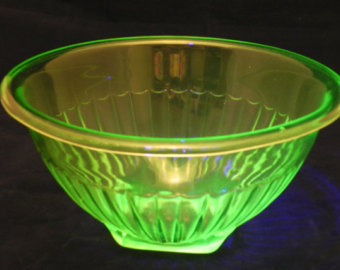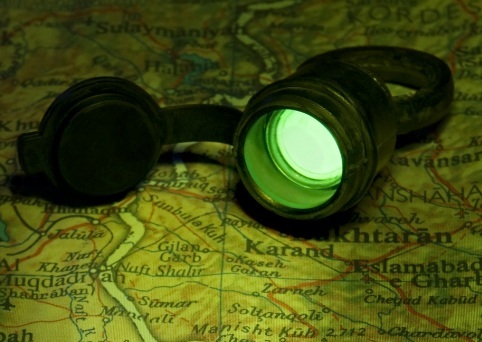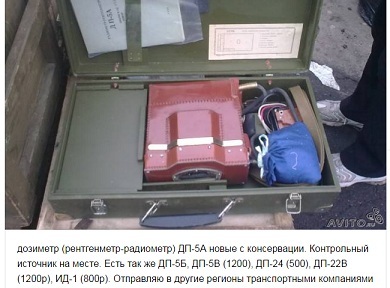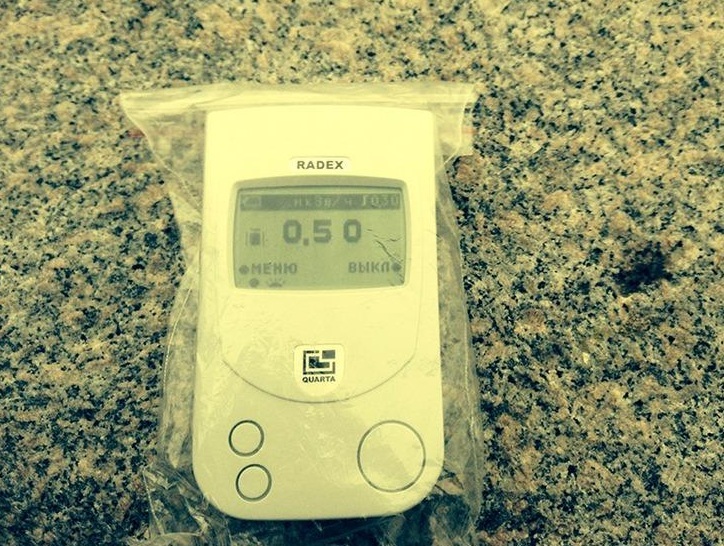Radiation and radioactive artifacts in everyday life - is it worth being afraid of them?
Hi geektimes. I was pushed to write this article by a news article in which a photographer accidentally discovered that one of his lenses was radioactive (there really were — before the 60s, thorium was added to the lenses). Further, this photographer tried to save himself and humanity from a terrible threat, and was looking for where he could hand over the lens for disposal. Do I need to do this, and how dangerous are such items? Let's try to figure it out.
In addition, a simple question for readers to backfill: walking in the crowded center of the city, you found an object with a radiation of 50 μR / h, which is 3 times more than the average. What to do?
1) Nothing
2) Call the police
3) Call the Ministry of Emergency Situations
4) Protect the place from outsiders
5) Quickly escape
6) Nothing - it's too late to do something. The
correct answer is under the cut at the end of the article.
To begin with, let us examine which levels of exposure are dangerous and which are not.
First, the radiation itself, meaningless to fear - it is always and everywhere. On the Internet it is easy to find out the current radiation background. Moreover, every second our body is penetrated by dozens of high-energy particles from space, which can even be detected using a digital camera . Therefore, speaking of radiation, it is worth talking not about its presence (it is always there), but about the absorbed dosefor a certain period of time. And here everything is simple - according to SanPiN 2.6.1.2800-10, an acceptable dose for the population from natural sources, it is considered 5 milliVc (or 575000 mkR) per year. What is easy to translate into hours, and get 575000 / (365 * 24) = 65 μR / hour. In reality, of course, the background is noticeably smaller, and in St. Petersburg, for example, it is about 13 μR / hour.
Above it was about natural sources. Ordinary fluorography gives 0.05 mSv, or 5750 mkR, x-ray of the jaw - 0.02 mSv or 2300 mkR. Few people know, but even during normal flight, a person is exposed to radiation up to 200 μR / hour, which is 10–20 times higher than the Earth’s level (at high altitudes, the levels of cosmic radiation are higher, because it is less shielded by the atmosphere).
Armed with the above figures, let's move on to practice. Where does radiation come from in everyday life? It seems to be no place, however, a person can still collide with such objects - up to the 60th radioactive materials were widely used.
Many lenses produced before the 60s have thorium in the glass, which gives some radioactivity. A typical example of SMC Takumar 50 / 1.4, such lenses are easily distinguished by the yellowish shade of glass.

On the surface, such a lens can produce up to 200 μR / hour, which horrifies an unprepared man in the street. However, is it a lot or a little? 200 μR / hour is the radiation level in the cabin of the aircraft, at which the pilots fly several hours every day and do not complain about health. Such a lens must be pressed to the chest for 30 hours in order to receive a dose equivalent to a single x-ray, or 10 hours to a tooth in order to receive a dose equivalent to an x-ray of the jaw. To get the maximum permitted SanPiN annual dose of 575000 mcR, such a lens must be worn on the body for 120 days. In addition, the power of any source decreases in proportion to the square of the distance, and already in 20cm the background of such a lens is not above the norm. Those. if you shoot a digital camera without holding it close to your body, then there is no harm at all.
Unfortunately, both the post office and the customs, in this plan, adhere to other standards - when trying to order such a lens by mail or when trying to transport it at the airport, it may well be withdrawn by customs officers. De jure, they are right - if you sleep with such a lens under a pillow every day, you can exceed the annual dose, de facto, of course, such exemptions are quite absurd.
Another well-known example of "radioactive artifacts" is radium phosphor, which was previously actively used to apply luminous marks on the dials of various instruments (clocks, gauges). A famous example is Adrianov’s compass.

The background from such a compass (more precisely, yellow marks on it) can reach 300 μR / h, so you shouldn’t wear it on your hand (it’s about old models, modern ones look the same, but the composition of the mass is different). If the compass is just lying on the shelf, then there is no danger, but there is one “but” - if the light does not crumble. Radium particles in the body can cause cancer, which of course, very seriously. SPD can also emit radon gas, therefore, such an item should be stored in an airtight bag.
Another interesting historical artifact - uranium glass, was very actively produced in the last century. The level of radiation from it is very small, and it does not pose a danger, but the production itself was very harmful, now such glass is obviously not done. Therefore, such items have a small but historic value.
An interesting feature of these glasses: they glow in the ultraviolet, an example of a photo with eBay:

Widely sold now in stores, the range from the smallest luminous key chains, to large lanterns.

They shine weakly, the stated luminescence period is about 10 years, if they are not swallowed, they are not dangerous
At almost any online flea market you can see old dosimeters written off (for example, DP-5A), which include a control source for verification. Screenshot from avito:

Of course, such sources do not represent a real danger to the user, otherwise they would not be included in the package. However, the danger is different here - the purchase / sale of such radioactive materials is regulated by article 220 of the Criminal Code of the Russian Federation, according to which the penalty can be up to 2 years in prison. What is obvious is hardly good for health ... It is not known whether there is a real practice of such cases, but there is no need to take risks.
As suggested in the comments, there are control sources from old dosimeters (for example, DP-2), which can produce more than 3000 μR / h, such of course you should not keep in any case.
I hope, a rough understanding of the sources and levels of possible household radiation, the readers have appeared. If very briefly, then in everyday life it is almost impossible to encounter a radiation source giving a real danger to health (unless, of course, not living in Chernobyl). Another thing is landfills and other abandoned places, theoretically, anything can get there, but this is difficult to attribute to “everyday” (anyone can explore this topic in more detail).
What should I do if I still have a vibrant object at home, for example, the grandfather's clock? To begin with, it is worthwhile to find a dosimeter and measure the radiation, to determine the distance at which the background is not above the norm. It is possible that the clock does not emit at all, and the paint used in them is not radioactive. If still radioactive, there are several options:
1) If a thing is expensive as a memory or family heirloom, it is enough to put an object at a safe distance at which the radiation does not exceed the norm (if there is no dosimeter, this distance can be considered 1 meter, in real life it will most likely be less). In the case of SPD, it is also worth putting the watch in a sealed bag and, of course, exclude children’s access. As suggested in the comments, you cannot use a vacuum cleaner if SPDs spill - microparticles can scatter around the room. In the case of lenses, everything is simpler, thorium is fused with glass, and it cannot fall off and enter the body. By the way, contrary to the popular myth, when stored near the object, other objects do not become radioactive. So storing the clock in the closet on the shelf in this regard is completely safe.
2) If you basically do not want to have a radioactive object at home, you can call the Emergency Situations Ministry and find out about recycling. But it is better to first ask on the "watch" or "historical" online forums - perhaps these watches have historical value, and collectors will gladly take them, despite the background.
And finally, the promised answer to the question at the beginning of the article.
In addition, a simple question for readers to backfill: walking in the crowded center of the city, you found an object with a radiation of 50 μR / h, which is 3 times more than the average. What to do?
1) Nothing
2) Call the police
3) Call the Ministry of Emergency Situations
4) Protect the place from outsiders
5) Quickly escape
6) Nothing - it's too late to do something. The
correct answer is under the cut at the end of the article.
Theory
To begin with, let us examine which levels of exposure are dangerous and which are not.
First, the radiation itself, meaningless to fear - it is always and everywhere. On the Internet it is easy to find out the current radiation background. Moreover, every second our body is penetrated by dozens of high-energy particles from space, which can even be detected using a digital camera . Therefore, speaking of radiation, it is worth talking not about its presence (it is always there), but about the absorbed dosefor a certain period of time. And here everything is simple - according to SanPiN 2.6.1.2800-10, an acceptable dose for the population from natural sources, it is considered 5 milliVc (or 575000 mkR) per year. What is easy to translate into hours, and get 575000 / (365 * 24) = 65 μR / hour. In reality, of course, the background is noticeably smaller, and in St. Petersburg, for example, it is about 13 μR / hour.
Above it was about natural sources. Ordinary fluorography gives 0.05 mSv, or 5750 mkR, x-ray of the jaw - 0.02 mSv or 2300 mkR. Few people know, but even during normal flight, a person is exposed to radiation up to 200 μR / hour, which is 10–20 times higher than the Earth’s level (at high altitudes, the levels of cosmic radiation are higher, because it is less shielded by the atmosphere).
Practice
Armed with the above figures, let's move on to practice. Where does radiation come from in everyday life? It seems to be no place, however, a person can still collide with such objects - up to the 60th radioactive materials were widely used.
Optics and lenses
Many lenses produced before the 60s have thorium in the glass, which gives some radioactivity. A typical example of SMC Takumar 50 / 1.4, such lenses are easily distinguished by the yellowish shade of glass.

On the surface, such a lens can produce up to 200 μR / hour, which horrifies an unprepared man in the street. However, is it a lot or a little? 200 μR / hour is the radiation level in the cabin of the aircraft, at which the pilots fly several hours every day and do not complain about health. Such a lens must be pressed to the chest for 30 hours in order to receive a dose equivalent to a single x-ray, or 10 hours to a tooth in order to receive a dose equivalent to an x-ray of the jaw. To get the maximum permitted SanPiN annual dose of 575000 mcR, such a lens must be worn on the body for 120 days. In addition, the power of any source decreases in proportion to the square of the distance, and already in 20cm the background of such a lens is not above the norm. Those. if you shoot a digital camera without holding it close to your body, then there is no harm at all.
Unfortunately, both the post office and the customs, in this plan, adhere to other standards - when trying to order such a lens by mail or when trying to transport it at the airport, it may well be withdrawn by customs officers. De jure, they are right - if you sleep with such a lens under a pillow every day, you can exceed the annual dose, de facto, of course, such exemptions are quite absurd.
Permanent Action Phosphor (SPD)
Another well-known example of "radioactive artifacts" is radium phosphor, which was previously actively used to apply luminous marks on the dials of various instruments (clocks, gauges). A famous example is Adrianov’s compass.

The background from such a compass (more precisely, yellow marks on it) can reach 300 μR / h, so you shouldn’t wear it on your hand (it’s about old models, modern ones look the same, but the composition of the mass is different). If the compass is just lying on the shelf, then there is no danger, but there is one “but” - if the light does not crumble. Radium particles in the body can cause cancer, which of course, very seriously. SPD can also emit radon gas, therefore, such an item should be stored in an airtight bag.
Uranium glass
Another interesting historical artifact - uranium glass, was very actively produced in the last century. The level of radiation from it is very small, and it does not pose a danger, but the production itself was very harmful, now such glass is obviously not done. Therefore, such items have a small but historic value.
An interesting feature of these glasses: they glow in the ultraviolet, an example of a photo with eBay:

Tritium key chains
Widely sold now in stores, the range from the smallest luminous key chains, to large lanterns.

They shine weakly, the stated luminescence period is about 10 years, if they are not swallowed, they are not dangerous
Control sources in military dosimeters
At almost any online flea market you can see old dosimeters written off (for example, DP-5A), which include a control source for verification. Screenshot from avito:

Of course, such sources do not represent a real danger to the user, otherwise they would not be included in the package. However, the danger is different here - the purchase / sale of such radioactive materials is regulated by article 220 of the Criminal Code of the Russian Federation, according to which the penalty can be up to 2 years in prison. What is obvious is hardly good for health ... It is not known whether there is a real practice of such cases, but there is no need to take risks.
As suggested in the comments, there are control sources from old dosimeters (for example, DP-2), which can produce more than 3000 μR / h, such of course you should not keep in any case.
findings
I hope, a rough understanding of the sources and levels of possible household radiation, the readers have appeared. If very briefly, then in everyday life it is almost impossible to encounter a radiation source giving a real danger to health (unless, of course, not living in Chernobyl). Another thing is landfills and other abandoned places, theoretically, anything can get there, but this is difficult to attribute to “everyday” (anyone can explore this topic in more detail).
What should I do if I still have a vibrant object at home, for example, the grandfather's clock? To begin with, it is worthwhile to find a dosimeter and measure the radiation, to determine the distance at which the background is not above the norm. It is possible that the clock does not emit at all, and the paint used in them is not radioactive. If still radioactive, there are several options:
1) If a thing is expensive as a memory or family heirloom, it is enough to put an object at a safe distance at which the radiation does not exceed the norm (if there is no dosimeter, this distance can be considered 1 meter, in real life it will most likely be less). In the case of SPD, it is also worth putting the watch in a sealed bag and, of course, exclude children’s access. As suggested in the comments, you cannot use a vacuum cleaner if SPDs spill - microparticles can scatter around the room. In the case of lenses, everything is simpler, thorium is fused with glass, and it cannot fall off and enter the body. By the way, contrary to the popular myth, when stored near the object, other objects do not become radioactive. So storing the clock in the closet on the shelf in this regard is completely safe.
2) If you basically do not want to have a radioactive object at home, you can call the Emergency Situations Ministry and find out about recycling. But it is better to first ask on the "watch" or "historical" online forums - perhaps these watches have historical value, and collectors will gladly take them, despite the background.
And finally, the promised answer to the question at the beginning of the article.
Answer
50мкР/ч — это уровень гранитной набережной Санкт-Петербурга. Исходя из этого, правильную цифру ответа читатели могут выбрать сами.


